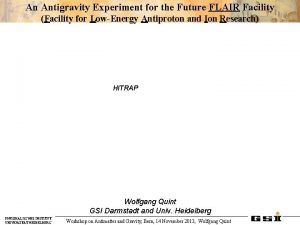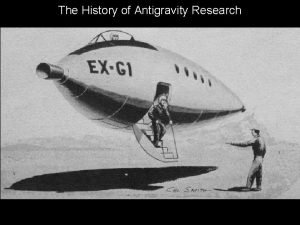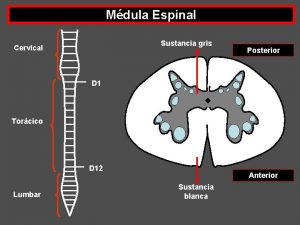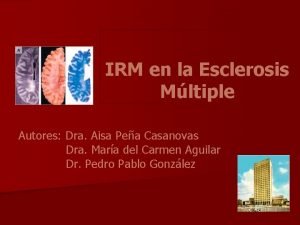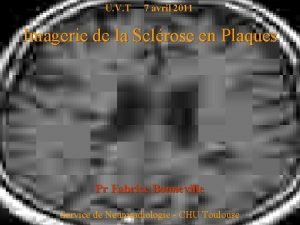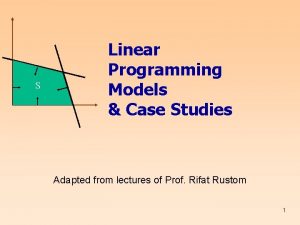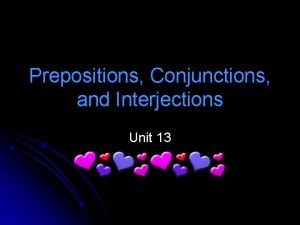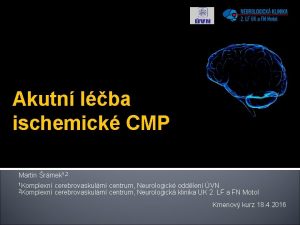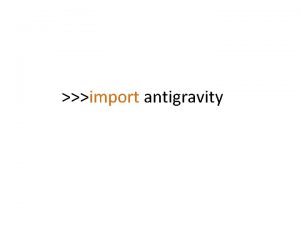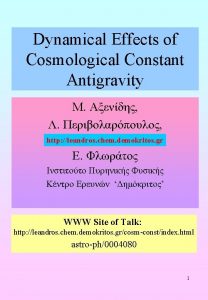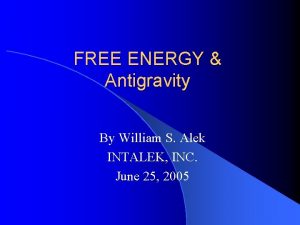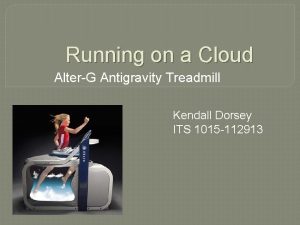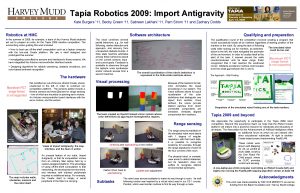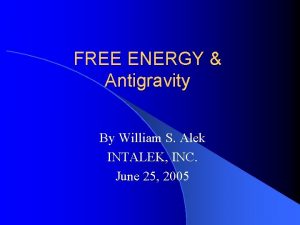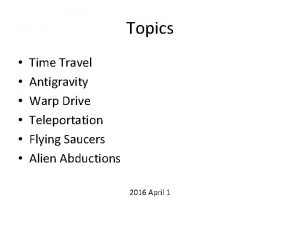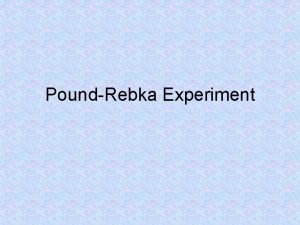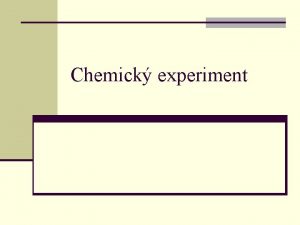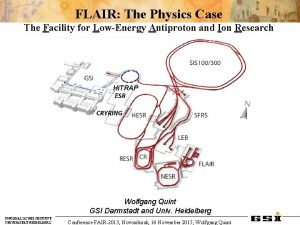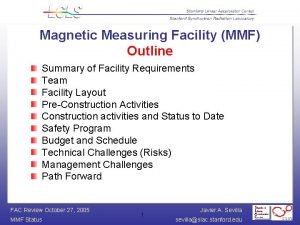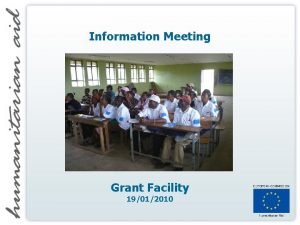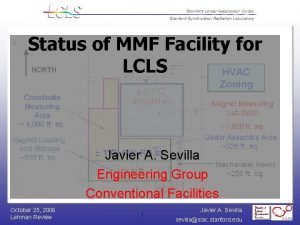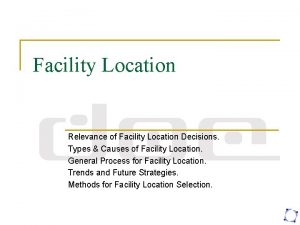An Antigravity Experiment for the Future FLAIR Facility
















![Electronic detection signal Evaporative Cooling of Protons Cyclotron frequency [MHz] Direct evaporative cooling of Electronic detection signal Evaporative Cooling of Protons Cyclotron frequency [MHz] Direct evaporative cooling of](https://slidetodoc.com/presentation_image/bf800444ec87c4723c5b7975e93cd9e1/image-17.jpg)















- Slides: 32

An Antigravity Experiment for the Future FLAIR Facility (Facility for Low-Energy Antiproton and Ion Research) HITRAP Wolfgang Quint GSI Darmstadt and Univ. Heidelberg PHYSIKALISCHES INSTITUT UNIVERSITÄT HEIDELBERG Workshop on Antimatter and Gravity, Bern, 14 November 2013, Wolfgang Quint

FLAIR - Facility for Low-Energy Antiproton and Ion Research • NESR – Pbars and ions – 30 – 400 Me. V FLAIR • LSR – Magnetic ring – Min. 300 ke. V (former CRYRING) • USR – Electrostatic ring – Min. 20 ke. V • HITRAP – Pbars and ions – Stopped & extracted @ 5 ke. V PHYSIKALISCHES INSTITUT UNIVERSITÄT HEIDELBERG energy range: 400 Me. V – 1 me. V Workshop on Antimatter and Gravity, Bern, 14 November 2013, Wolfgang Quint

FLAIR@ FAIR - Baseline Technical Report • High-brightness low-energy beams • Electron cooling • ε ~ 1 π mm mrad, Δp/p ~ 10– 4 • Storage rings with internal targets • Slow and fast extraction • HITRAP facility for HCI & pbar • New experiments possible • Same facilities can be used for highly charged ions (HCI) PHYSIKALISCHES INSTITUT UNIVERSITÄT HEIDELBERG Workshop on Antimatter and Gravity, Bern, 14 November 2013, Wolfgang Quint

FLAIR - Facility for Low-Energy Antiproton and Ion Research Courtesy: Horst Stöcker Courtesy: Wolfgang Quint PHYSIKALISCHES INSTITUT UNIVERSITÄT HEIDELBERG Workshop on Antimatter and Gravity, Bern, 14 November 2013, Wolfgang Quint

Cryring (Stockholm) for LSR (Low-Energy Storage Ring) at FLAIR • Beam delivery for HITRAP, USR, experiments • Fitting energy range, electron cooling • Fast ramping, internal target • CRYRING has been contributed by Sweden as in-kind contribution to FAIR PHYSIKALISCHES INSTITUT UNIVERSITÄT HEIDELBERG Workshop on Antimatter and Gravity, Bern, 14 November 2013, Wolfgang Quint

USR – Ultra-Low Energy Storage Ring Emin / Emax 20 / 300 ke. V Dimensions 8 mx 8 m Voltages < ± 20 k. V Number of pbars at 20 ke. V 1· 107 PHYSIKALISCHES INSTITUT UNIVERSITÄT HEIDELBERG C. Welsch et al. GSI/Cockcroft Institute Liverpool Workshop on Antimatter and Gravity, Bern, 14 November 2013, Wolfgang Quint

The HITRAP Facility for Heavy Highly Charged Ions and Antiprotons HITRAP will deliver 5 ke. V antiprotons to low-energy experiments Precision trap Other experimental setups, second floor Double-drift-buncher HCI from NESR, antiprotons from LSR PHYSIKALISCHES INSTITUT UNIVERSITÄT HEIDELBERG IH-structure RFQ cooler trap To exp. areas 4 Me. V/u 0. 5 Me. V/u 6 ke. V/u Workshop on Antimatter and Gravity, Bern, 14 November 2013, Wolfgang Quint ground floor

FLAIR: Research Topics with Low-Energy Antiprotons EXPERIMENTS WITH ANTIPROTONS AT EXTREMELY LOW ENERGIES · fundamental interactions - CPT (antihydrogen, HFS, magnetic moment) - gravitation of antimatter · atomic collision studies ATHENA Nature 419 (2002) 456 - ionization - energy loss - matter-antimatter collisions · antiprotonic atoms M. Hori et al. , PRL 92 (2003) 123401 - formation - strong interaction and surface effects A. Trzcinska, J. Jastrzebski et al. PRL 87 (2001) 082501 PHYSIKALISCHES INSTITUT UNIVERSITÄT HEIDELBERG Workshop on Antimatter and Gravity, Bern, 14 November 2013, Wolfgang Quint

A New Route Towards an Antihydrogen Gravity Experiment Our approach is to first build an off-line mirror experiment with matter, as a testing ground for our methods. New approaches to trapping and cooling of charged particles (MPI-K and GSI/FLAIR) with general methods of trapping and cooling of neutral atoms (Univ. of Texas at Austin) The basic strategy of the mirror system is to trap and cool protons and electrons in a cryogenic Penning trap. The protons will then be launched to form a beam of neutral hydrogen atoms, which will be stopped and cooled. PHYSIKALISCHES INSTITUT UNIVERSITÄT HEIDELBERG Workshop on Antimatter and Gravity, Bern, 14 November 2013, Wolfgang Quint

Tasks to Charged Particle Storage • Storage of a large number of protons and electrons • Sensitive non-destructive detection 108 1 • Fast cooling of the charged particles ms-s • Efficient cooling of antiprotons ? ? ? PHYSIKALISCHES INSTITUT UNIVERSITÄT HEIDELBERG Workshop on Antimatter and Gravity, Bern, 14 November 2013, Wolfgang Quint

Single Charged Particle Stored in a Penning Trap PHYSIKALISCHES INSTITUT UNIVERSITÄT HEIDELBERG Workshop on Antimatter and Gravity, Bern, 14 November 2013, Wolfgang Quint

Highly Charged Ion g-Factor Apparatus at Mainz (Coll. GSI + MPI-K): Tests of Quantum Electrodynamics in Strong Fields PHYSIKALISCHES INSTITUT UNIVERSITÄT HEIDELBERG Workshop on Antimatter and Gravity, Bern, 14 November 2013, Wolfgang Quint

Electronic detection of a single trapped ion: Resistive cooling to 4 K and active feedback cooling to < 1 K B complex electronics feedback cooling end cap G f T<1 K compensation electrode ring electrode z = 680 k. Hz C R L U=IR compensation electrode end cap 9 cm d. Ek/dt = Pcool = -I 2 R resistive cooling T=4 K PHYSIKALISCHES INSTITUT UNIVERSITÄT HEIDELBERG Workshop on Antimatter and Gravity, Bern, 14 November 2013, Wolfgang Quint

High-resolution cyclotron frequency measurement of a single highly charged silicon ion 28 Si 13+ PHYSIKALISCHES INSTITUT UNIVERSITÄT HEIDELBERG Workshop on Antimatter and Gravity, Bern, 14 November 2013, Wolfgang Quint

Resistive Cooling of Trapped 12 C 5+ Ions to T = 4 K PHYSIKALISCHES INSTITUT UNIVERSITÄT HEIDELBERG Workshop on Antimatter and Gravity, Bern, 14 November 2013, Wolfgang Quint

Determination of the (Anti)Proton g-Factor BASE Collaboration at AD/CERN, Spokesperson: Stefan Ulmer Cyclotron frequency Larmor frequency analysis trap precision trap PHYSIKALISCHES INSTITUT UNIVERSITÄT HEIDELBERG Workshop on Antimatter and Gravity, Bern, 14 November 2013, Wolfgang Quint
![Electronic detection signal Evaporative Cooling of Protons Cyclotron frequency MHz Direct evaporative cooling of Electronic detection signal Evaporative Cooling of Protons Cyclotron frequency [MHz] Direct evaporative cooling of](https://slidetodoc.com/presentation_image/bf800444ec87c4723c5b7975e93cd9e1/image-17.jpg)
Electronic detection signal Evaporative Cooling of Protons Cyclotron frequency [MHz] Direct evaporative cooling of antiprotons is not viable, since it would lead to a huge loss in number. PHYSIKALISCHES INSTITUT UNIVERSITÄT HEIDELBERG Workshop on Antimatter and Gravity, Bern, 14 November 2013, Wolfgang Quint

Sympathetic Evaporative Cooling Direct laser cooling of negative ions is not promising. Evaporative cooling can be conveniently done by tuning of a photo-detachment laser. PHYSIKALISCHES INSTITUT UNIVERSITÄT HEIDELBERG Workshop on Antimatter and Gravity, Bern, 14 November 2013, Wolfgang Quint

Tasks to Neutral Particle Storage • Deceleration and stopping of a neutral particle beam done • Cooling of neutral H atoms soon • Detection of stored H atoms in prog. • Precision experiments ? ? ? Ref. : M. Raizen, Univ. of Texas at Austin PHYSIKALISCHES INSTITUT UNIVERSITÄT HEIDELBERG Workshop on Antimatter and Gravity, Bern, 14 November 2013, Wolfgang Quint

Towards Magnetic Trapping Ref. : M. Raizen PHYSIKALISCHES INSTITUT UNIVERSITÄT HEIDELBERG Workshop on Antimatter and Gravity, Bern, 14 November 2013, Wolfgang Quint

Atomic Coilgun • Directly slow and stop a beam of paramagnetic atoms Analogy to Stark Decelerator: F. Merkt (Zürch), G. Meijers (Berlin) Efficiency: 2 -10% Temperature: 80 m. K Ref. : M. Raizen PHYSIKALISCHES INSTITUT UNIVERSITÄT HEIDELBERG Most atoms in periodic table elements are paramagnetic E. Narevicius et al. , Phys. Rev. Lett. 100, 093003 (2008) Workshop on Antimatter and Gravity, Bern, 14 November 2013, Wolfgang Quint

Atom Trapping g T (µK) z (mm) Ref. : M. Raizen PHYSIKALISCHES INSTITUT UNIVERSITÄT HEIDELBERG Workshop on Antimatter and Gravity, Bern, 14 November 2013, Wolfgang Quint

Single-Photon Atomic Cooling by One-Way Barrier → Maxwell’s Demon one-way barrier 100 mm T ~ a few m. K 100 mm 350 x increase in phase space density from magnetic trap! Ref. : M. Raizen, Science 324, 1403 (2009) PHYSIKALISCHES INSTITUT UNIVERSITÄT HEIDELBERG G. Price et al. , Phys. Rev. Lett. 100, 093003 (2008) Workshop on Antimatter and Gravity, Bern, 14 November 2013, Wolfgang Quint

Single-Photon Atomic Cooling by One-Way Barrier → Maxwell’s Demon one-way barrier Key points: • Laser beam M is attractive for state 1, but repulsive for state 2. • Laser beam RES optically pumps into state 2. Ref. : M. Raizen et al. , PRL 94, 053003 (2005) PHYSIKALISCHES INSTITUT UNIVERSITÄT HEIDELBERG Workshop on Antimatter and Gravity, Bern, 14 November 2013, Wolfgang Quint

Laser Scheme for Single-Photon Cooling 1) Diode laser with tapered amplifier at l = 972 nm. 2) Frequency doubling in a resonant build-up cavity to l = 486 nm. 3) Frequency doubling in a resonant build-up cavity to l = 243 nm. 5 m. W output power. 4) Confocal build-up cavity around the atoms. 100 x power increase. Ref. : M. Raizen PHYSIKALISCHES INSTITUT UNIVERSITÄT HEIDELBERG Workshop on Antimatter and Gravity, Bern, 14 November 2013, Wolfgang Quint

Precision Measurement of gbar/g • Excite H-bar to 2 S state (lifetime 120 ms) • Raman interferometry (see talk by Susannah Dickerson) between hyperfine states of 2 S (177 MHz) • Raman laser beams at 657 nm (near 2 S-3 P transition) • 1000 atoms, T = 30 ms: g-bar/g = 2 x 10 -7 per shot Averaging over one year @ 40 shots per day: reach 5 x 10 -9 Ref. : M. Raizen PHYSIKALISCHES INSTITUT UNIVERSITÄT HEIDELBERG Workshop on Antimatter and Gravity, Bern, 14 November 2013, Wolfgang Quint

Detection of Neutral Stored Hydrogen Atoms 1. Drive a transition to the 2 S state in the m=1 state. 2. Launch the atoms magnetically with a coil. 3. Detection with a neutral particle detector. Space resolving MCP detector. G. Eitel et al. , NIMA, 606, 475 (2009) Ref. : M. Raizen PHYSIKALISCHES INSTITUT UNIVERSITÄT HEIDELBERG Workshop on Antimatter and Gravity, Bern, 14 November 2013, Wolfgang Quint

Summary Four-step solution 1. Storage of a large number of p and e, form H beam 2. Atomic coilgun for deceleration and stopping of H 3. Single-photon cooling 4. Neutral H detection Thanks a lot for the invitation and your attention! Email: raizen@physics. utexas. edu klaus. blaum@mpi-hd. mpg. de w. quint@gsi. de PHYSIKALISCHES INSTITUT UNIVERSITÄT HEIDELBERG Workshop on Antimatter and Gravity, Bern, 14 November 2013, Wolfgang Quint

Announcement of FLAIR Collaboration Meeting and Workshop: 15/16 May 2014 at MPI-K Heidelberg Topics: • • Experiments with antiprotons and antihydrogen Highly charged ions in traps and rings for spectroscopy Interaction of low-energy highly charged ions and pbars with targets Advances in theory of antimatter and exotic ions Nuclear and particle physics with antiprotons Heavy-ion experiments, ion surface interactions, collision dynamics Antiprotonic atom X-ray spectroscopy New instrumentation and facilities PHYSIKALISCHES INSTITUT UNIVERSITÄT HEIDELBERG Workshop on Antimatter and Gravity, Bern, 14 November 2013, Wolfgang Quint

FLAIR: Antiproton Intensities SIS 100: acceleration of 2. 8 1013 protons, E = 29 Ge. V Antiproton target: production of 1. 0 108 pbars/ 5 s, E = 3 Ge. V Collector ring CR: fast stochastic cooling in 10 s, N = 108/cycle RESR: accumulation of pbars, N = 108 – 1011 NESR: electron cooling, deceleration from 3 Ge. V to 30 Me. V FLAIR LSR: deceleration from 30 to 0. 3 Me. V HITRAP: deceleration from 4 Me. V to rest, av. intensity: 1 x 106/s USR: deceleration from 300 to 20 ke. V, av. intensities: • Reff = 1 x 1012/s at 300 ke. V • Rextr = 1 x 106 /s at 300 ke. V • Reff = 1 x 1010/s at 20 ke. V • Rextr = 5 x 105 /s at 20 ke. V pbar experimental areas: E = 400 Me. V to 5 ke. V PHYSIKALISCHES INSTITUT UNIVERSITÄT HEIDELBERG Workshop on Antimatter and Gravity, Bern, 14 November 2013, Wolfgang Quint

FLAIR - Facility for Low-Energy Antiproton and Ion Research HITRAP We need a transfer line from the Collector Ring to the ESR. PHYSIKALISCHES INSTITUT UNIVERSITÄT HEIDELBERG Workshop on Antimatter and Gravity, Bern, 14 November 2013, Wolfgang Quint

Alternative for the Implementation of FLAIR HITRAP If we will have a transfer line from the Collector Ring to the ESR, then • the ESR can take over a part of the tasks of the NESR, • CRYRING is the LSR of FLAIR, • HITRAP can decelerate antiprotons, and • the USR can be attached to CRYRING. = nearly the full FLAIR facility (except for the neighbourhood to rare isotopes) PHYSIKALISCHES INSTITUT UNIVERSITÄT HEIDELBERG Workshop on Antimatter and Gravity, Bern, 14 November 2013, Wolfgang Quint
 Antigravity
Antigravity Antigravity research
Antigravity research Future perfect form
Future perfect form Future perfect simple and continuous
Future perfect simple and continuous Lesiones hiperintensas en t2 y flair
Lesiones hiperintensas en t2 y flair Journalistic flair
Journalistic flair Flair furniture company linear programming
Flair furniture company linear programming Lesiones hiperintensas en t2 y flair
Lesiones hiperintensas en t2 y flair Doigts de dawson
Doigts de dawson Four special cases in linear programming
Four special cases in linear programming Linear programming case study examples
Linear programming case study examples Prepositionsl phrase
Prepositionsl phrase Dwi flair mismatch
Dwi flair mismatch Future continuous
Future continuous Travel present continuous tense
Travel present continuous tense 1 2 3 kondicional u engleskom jeziku
1 2 3 kondicional u engleskom jeziku Future continuous and future perfect
Future continuous and future perfect Tense
Tense The perfect future tense
The perfect future tense Future nurse future midwife
Future nurse future midwife Future plans and finished future actions
Future plans and finished future actions Past continuous and future continuous
Past continuous and future continuous Simple present tense simple past tense simple future tense
Simple present tense simple past tense simple future tense Formel standardavvikelse
Formel standardavvikelse Atmosfr
Atmosfr Rutin för avvikelsehantering
Rutin för avvikelsehantering Myndigheten för delaktighet
Myndigheten för delaktighet Presentera för publik crossboss
Presentera för publik crossboss Treserva lathund
Treserva lathund Tack för att ni lyssnade
Tack för att ni lyssnade Hur skriver man en tes
Hur skriver man en tes Kung dog 1611
Kung dog 1611 Nationell inriktning för artificiell intelligens
Nationell inriktning för artificiell intelligens
